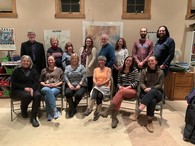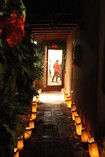
|
December 2022 Newsletter
|
Open Space Division Presents the Master Naturalist Program

Sustainability Office Volunteer Coordinator, Nav Khalsa, presented in the recent Board of County Commissioners meeting on the highlights of a vitally important Master Naturalist program. The in-depth volunteer training and hours of stewardship contributed through this program provide the community with healthier ecosystems for wildlife and increased biodiversity in the County's Open Spaces. The Master Naturalist Program was launched in 2018 through a partnership between Santa Fe County’s Open Space Division, the Santa Fe Botanical Garden, and Audubon Southwest. The program serves many functions throughout the community and numerous County departments including Public Works, Growth Management, and the Sustainability Office's climate action planning goals directly tied to the 30x30 Initiative, stormwater management with MS4 Reporting, and Natural Climate Solutions.
Master Naturalist volunteers participate in 55 hours of classroom learning and field trips over 12 weeks where they learn about New Mexico’s ecology and environmental issues. They then complete 30 volunteer hours with one of the program’s partner agencies. Master Naturalist projects within the Santa Fe County Open Space Division have included removing invasive plants, monitoring for wildlife, and installing erosion control devices. Over the last year, Master Naturalists have participated in 25 workdays to help protect and restore County open spaces! A new cohort of Master Naturalists completed their classroom learning last month and will begin volunteer projects in the new year to continue the support of numerous broader County initiatives to conserve and restore land, protect water quality, and increase resiliency to climate change.
Thank you to the Master Naturalists for their important contributions to the County and to the County Open Space Division, Santa Fe Botanical Garden, Audubon Southwest, and numerous guest presenters for making this program a success!
Click here to learn more about the Northern New Mexico Master Naturalist Program and here to watch the BCC presentation (at 2 hr. 32 min).
|
Evergreen Appreciation

If you are looking for a Christmas tree this year, consider purchasing a live evergreen that you can enjoy for years to come. This holiday season we highlight just a few native evergreens that play an important role in our local ecosystems year-round!
-
Piñon pine (Pinus edulis): The piñon pine grows throughout the southwest and is the official state tree of New Mexico. Piñon pines are bushy trees that grow approximately 10-35 feet tall and can live up to 1,000 years! The piñon pine begins producing cones at about 25 years old and cones take two years to mature. The tree produces tasty seeds that are enjoyed by both people and wildlife. The seeds are an important food source for the pinyon jay, a blue-gray bird that travels in flocks harvesting and caching piñon seeds for later consumption. While pinyon jays can recall the locations of numerous hidden seed stashes, they have effectively planted a new piñon pine in any locations they miss. Unfortunately, climate change threatens the survival of both piñon pines and the pinyon jay. Check out Audubon Southwest to learn how you can help collect data to inform conservation efforts!
-
Ponderosa Pine (Pinus ponderosa): Head up to a higher elevation and you will encounter majestic ponderosa pines. These stately trees can grow to more than 200 feet tall and live for over 500 years. Ponderosa pines have thick scaly bark that smells of butterscotch or vanilla. This bark helps mature ponderosa pines withstand low intensity fires. The tree also sheds its lower limbs, which helps prevent fire from climbing up into the canopy. Historically, frequent low intensity fires burned understory vegetation leaving behind open stands of ponderosa pines. In the past, sunlight reached the forest floor and soft grasses blanketed the ground between ponderosa pines. Years of fire suppression have changed the composition of these forests, many of which are now denser and more shaded with little vegetation on the forest floor. Take a walk through a ponderosa forest and you may see Albert’s squirrels scurrying through the branches. These squirrels are easily recognized by their distinctive tufted ears and rely on ponderosa pines for food and shelter.
-
Rocky Mountain Juniper (Juniperus scopulorum): Rocky Mountain junipers grow to about 30 feet tall and produce berries that are enjoyed by birds and other wildlife. This bushy tree can be found at elevations of 5,000-9,000 feet in northern New Mexico. Rocky Mountain junipers are slow growing and long-lived. One of the oldest known trees in New Mexico is a Rocky Mountain juniper that is over 1,900 years old!
Santa Fe County is home to over 285,000 acres of evergreen forest that help to mitigate the effects of climate change through carbon sequestration, provide important wildlife habitat, and offer recreation opportunities. Keep an eye out for these stunning evergreens as you venture outdoors this winter!
|
Tips for a Green Winter

The holiday season has arrived! Below are just a few tips to green-up your winter celebrations:
-
Select sustainable gift wrap: Cut down on the amount of trash generated by choosing sustainable alternatives to wrapping paper. Try packaging gifts in bags, baskets, decorative boxes, or fabric that can be reused year after year. Decorate brown paper bags or repurpose old maps, magazines, or newspaper into gift wrap. If you do purchase wrapping paper, opt for rolls that are 100% paper and can be recycled. Keep in mind that paper with foil and glitter cannot be recycled.
-
Choose reusable plates and cutlery: In 2018, 830,000 tons of plastic cups, plates, and other food containers were sent to the landfill in the U.S. Help keep plastic dinnerware out of the landfill by providing reusable cups, glasses, and silverware at your upcoming holiday party.
-
Shop locally: Shop locally to support small businesses and cut down on the greenhouse gas emissions required to transport goods long distances.
-
Give sustainable gifts: Try gifting experiences, like a trip to a museum, a cooking class, or an outdoor adventure, rather than material items. You can also check out your local secondhand store or reuse center for supplies to create a homemade recycled gift! When purchasing toys, look for durable products made with recycled or sustainably sourced materials. Keep an eye out for companies that offer toy takeback or recycling programs to keep toys out of the landfill.
-
Minimize food waste: Consider how much food you need to buy for those special holiday meals and make a plan to properly store and use up any leftovers. Compost fruit and vegetable scraps at home or check out local compost pick-up and drop-off options.
Wishing all a holiday season full of joy, peace, and beautiful nature, from the Sustainability team!
|
|
Our December Picks
(Click on the blue titles for more information)
|

Tuesdays and Saturdays
8:00 AM - 1:00 PM
Check out the Santa Fe Farmer’s Market to incorporate locally produced food into your upcoming holiday meals. Click here to learn what is in season.

Wednesday, December 14
3:00 PM
Learn from the Director of Horticulture at Los Poblanos Historic Inn and Organic Farm during this webinar hosted by the New Mexico State University Cooperative Extension
|
|

Friday, December 9
8:30 AM - 10:00 AM
Join this webinar hosted by the New Mexico Coalition to Enhance Working Lands to learn about fire recovery and how communities can work together to manage fire risk.
Friday, December 16
4:00 - 7:00 PM
Enjoy activities at the Santa Fe Botanical Garden, Museum of International Folk Art, and Museum of Indian Arts and Culture during this special holiday event.
|
|

Saturday, December 10
9:00 AM - 4:00 PM
Shop local at these holiday arts and crafts fairs!

Saturday, December 24
Head over to Canyon Road to enjoy holiday lights and carols during the annual Farolito Walk!
|
|
|
|
|
|
|
Sharing
Share this issue with others! 
Sustainability Questions?
We are your local advisors on all things sustainability in Santa Fe County. Contact us with questions or to suggest topics for future newsletters!
Jacqueline Beam, jybeam@santafecountynm.gov
Nav Khalsa, nkhalsa@santafecountynm.gov
Caitlin Weber, cweber@santafecountynm.gov
Click to visit the Sustainability webpage
|
|